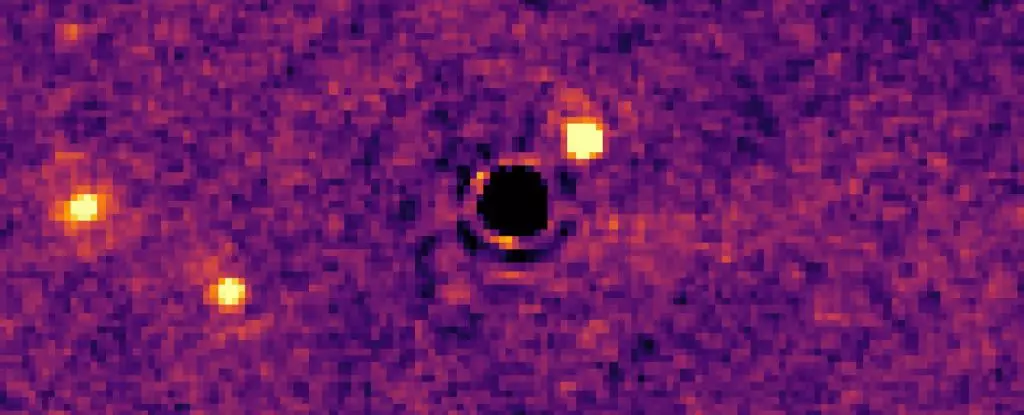The cosmos continues to surprise us with its intricate mysteries, and the James Webb Space Telescope (JWST) has taken another monumental step towards unraveling celestial enigmas. Recently, scientists announced the discovery of TWA-7b, a cold gas giant located 111 light-years away from Earth, making it the smallest exoplanet ever directly imaged. This breakthrough serves as a testament to the unparalleled capabilities of JWST, allowing us to peer into the depths of space and witness the formation of worlds beyond our own.
TWA-7b, orbiting its red dwarf star at a staggering distance—52 times farther than Earth’s orbit around the Sun—offers a unique opportunity to analyze the dynamics of planetary formation. With a mass approximately one-third that of Jupiter, this distant world resides in a region analogous to our Solar System’s Kuiper Belt. The implications of such a discovery are profound; it not only adds another celestial body to the growing catalog of exoplanets but also significantly enhances our understanding of the formation processes that govern planetary systems.
New Insights into Planetary Formation
Led by Anne-Marie Lagrange from the Paris Observatory, a research team has utilized the JWST’s Mid-Infrared Instrument (MIRI) to gain unprecedented insights into the intricate processes of planetary formation. The striking details captured by this advanced instrument have allowed researchers to confirm existing theories and predict new dynamics within the formation disks surrounding young stars. The very existence of TWA-7b corroborates long-held hypotheses about planetary birth, as these gas giants typically form from the accretion of material in such disks.
Moreover, the notion of ‘shepherding’ can be observed, where forming planets influence surrounding material, akin to how shepherd moons maintain the integrity of Saturn’s rings. While no specific planet has yet been identified responsible for these disk features, TWA-7b’s positioning grants us a clearer view into these vital processes. This discovery notably raises the bar for detection capabilities, suggesting that JWST can potentially image even smaller and lighter exoplanets than its current find.
Expanding the Universe of Exoplanet Research
The ongoing hunt for exoplanets is thrilling, with nearly 6,000 confirmed members currently recognized in our Milky Way galaxy. However, the bulk of these worlds remain elusive, primarily revealed through indirect methods that measure stellar light fluctuations due to planetary presence. The challenge in confirming these celestial bodies lies in their tiny size, dim glow, and considerable distance from Earth. Up until our latest breakthrough with TWA-7b, only around 80 exoplanets had been directly imaged—a stark contrast to the vast number of candidates detected indirectly.
Researchers assert that TWA-7’s exceptional orientation allows for a clear observation of its surrounding material, revealing three prominent rings. Such features transform it into a prime subject for directly imaging exoplanets, as the JWST captured TWA-7b’s light in remarkable clarity. This ability not only enhances the credibility of its detection but also heralds a new age, where direct imaging becomes a feasible technique for uncovering countless distant worlds.
Future Prospects: The Promising Path Ahead
The implications of JWST’s capabilities extend well beyond TWA-7b. As Lagrange and her team point out, the technology has emerged as a powerful tool in assessing sub-Jupiter-mass planets and offers the tantalizing possibility of discovering even lighter worlds—those weighing as little as 25 to 30 Earth masses. This level of sensitivity marks a significant evolution in exoplanetary studies, potentially revealing worlds previously deemed undetectable.
Direct imaging provides distinct advantages over indirect observation methods. For instance, it allows scientists to study the atmospheres of exoplanets more effectively, offering a nuanced understanding of chemical compositions, weather patterns, and overall habitability prospects. In the case of TWA-7b, researchers emphasize the planet’s suitability for detailed modeling of the intricate interactions between the planet and its surrounding disk, making it an invaluable asset for future research endeavors.
As our knowledge deepens, it becomes increasingly evident that we stand on the brink of transformative discoveries in the field of astronomy. The JWST’s groundbreaking findings bear not only the potential to elucidate planetary formation but also to challenge our very understanding of whether life exists elsewhere in the universe. Each new observation sprouts new branches of inquiry, rekindling the flames of curiosity that have driven humanity’s quest to understand existence beyond our fragile blue planet. The cosmos remains an ever-expanding frontier, inviting us to explore its depths and discover the mysteries that await.

